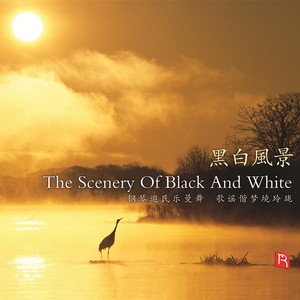
- 歌曲
- 时长
简介
黑白风景 The Scenery Of Black And White 钢琴邀民乐曼舞 歌谣偕梦境玲珑 那一瞬间,它们对话的秘密,被谁偷偷听去了。 风过竹林,穿不透欲暝的色与影。一番清泠的声响,便有无数露珠簌簌地离开了花叶。只是那雾霭,那薄于纱轻于虹的雾霭,在黎明的最后时分,与这黑白意象的竹林痴缠悱恻,在枝枝叶叶间氤氲馥郁。在朝阳即将升起的离别时刻,雾霭暗涌在竹林的每个细节,呢喃着它湿漉漉的眷恋。雾霭和竹林的对话,是缠绵的拂动。 睇惯了南国矜持的纤云弄巧,或是北国寥廓的云淡秋空,所以在青藏高原上空,看见云朵和山峦如此近如此亲昵的姿态,让人不由得怔忡。大团大团棉花糖似的云朵,仿佛是可以触碰和揉玩的,它活泼而肆意地挑逗着山峦。山峦装模作样地静默巍峨着,仿佛事不关己,然而峰顶的积雪却泄露了它俩千百万年来的游戏默契,那是云朵不慎留下的足迹。云朵和山峦的对话,是嬉游的亲吻。 眼际身畔那些无限接近的瞬间,似乎因了那样对话的奇异关系,而成为了曼妙的景观。 翅膀和天空的对话,是游弋的梦想。 水滴和海洋的对话,是融入的忘怀。 手指和黑发的对话,是纠结的撩拨。 幸福和光阴的对话,是渐黯的磨灭。 背影和门扉的对话,是远逝的流连。 那么,这钢琴黑白间或的玲珑,与民乐器明媚无伦的容颜,它们那悄然却默契的精妙对答,那样谐趣的、欣喜的、韵律的自然之音,惟有天籁才能形容了。 民歌有多美?“百里不同风,十里不同歌”,那一份活泼泼的情愫,像血脉一样在口耳传承中绵延;那无数绚丽或素朴的民歌花朵,百妍千态,芳馨袭人。 民歌本是直抒胸臆,即使毫无雕饰,意凭天成,也是粗服不掩国色,回眸便是惊艳。 有人说,民歌堪称音乐的“母语”。因此民歌便有了无数种奇幻变身的可能。作为乐器之王的西洋味的钢琴,来翻译中国的“母语”民歌,想想都会觉得太有趣。 所以,本辑选了十二首风格各异的中国经典民歌。地域而言,东抵吉林,西越新疆,南含台湾,北接蒙古,纵横中国的全部音乐版图;民族而言,包括汉族、朝鲜族、蒙古族、哈萨克族、布依族等多种纷繁异彩的民歌风情;风格而言,包容《半个月亮爬上来》的恬美,《云雀》的热烈,《森吉德玛》的哀伤,《无锡景》的温润,举凡十二支歌谣十二番面目,齐聚一堂已经熙熙攘攘,美不胜收。一旦和钢琴的西洋风格碰撞,立即火花四溅,灿烂满目! 钢琴超凡的独奏表现力,立时带给这些熟稔旋律以金玉叮当的璀璨外观。原本千锤百炼的民歌旋律,被乐器之王的矜贵气质提炼出了纯美的精髓。色彩纷繁个性耀眼的各色民乐器亦不遑多让,一声清吟或是点片击打,立时便勾出天高地远水色无边,钢琴作为和声乐器又在背景中恰到好处地点染,提供了多种混搭嬉玩的可能。那样丰富而绚丽的元素对话,真令人目不暇接。 《桂花要等贵人来》,巴乌和钢琴交缠成明朗馥郁的南国之夜; 《森吉德玛》,马头琴复生了草原的辽阔,钢琴徐缓抒情; 《道拉基》用二胡、笛和钢琴对答互问,在长鼓的韵律间翩翩起舞; 《夜了天》的灵动钢琴在尺八的倾诉里,幽美得几乎不现实; 哈萨克最俏丽的《云雀》,因为都塔尔、康加鼓和笛子的经典歌舞组合而保留了浓郁的民族气质,钢琴和打击乐又赋予它格外奔放热情的外观; 《无锡景》的琵琶和钢琴,仿佛评弹二角,错落有致娓娓道来江南水乡的轻倩可爱; 最甜美是那首笙和钢琴合鸣的《摇篮曲》,在轻柔舒缓之间,仿佛回到童年。 十二首惊艳转身的民歌,十二段充满倾诉的音乐幻想,在片刻聆听的旅程间时时体验着惊喜,仿佛十二段崭新的回忆。中国交响乐团钢琴演奏家冯丹素手轻调百万名琴,并在众多民乐器及少数民族乐器演奏家们精妙技艺的簇拥之下,梦笔生花,美不胜收。 为了完美记录和再现旋律的妩媚动人,亦为了凝炼保存编创演奏时的点滴灵感火花,令他们能够真切迫近地传递到每一个听者的耳中,专辑诚邀中国唯一进入TAS榜的著名录音师李小沛先生操刀,选用中央电视台480平米模拟录音棚精湛录制。德国著名的Pauler Acoustics录音棚全程严谨完成专辑的后期制作及母版制造。 这一段钢琴与民乐器趣致动人的对话,仿佛芬芳的水果遇见了醇美的冰淇淋,齿颊留香,始终是甜美和愉悦的。尽管在这聆听的旅行中也遇见过静谧的、伤感的甚至有些热辣的,然而听到最后还是一种渗到心底的甜蜜。这种甜蜜,缘于对某段记忆的迷蒙唤醒,缘于对精妙趣致的赏心悦目,缘于不意间的一种舒畅和兴奋,更或许,正是缘于一种缘。茫茫大千之中,两相物事相遇是缘,两种琴声对话是缘,而这一段呼吸和聆听,亦是缘罢。 Foreword: Being used to the music played by the piano and other western musical instruments, when you firstly listen to the one played by the piano and some oriental musical instruments such as Pipa, Bamboo flute and Guzheng etc, you may have a totally different hearing feeling just like fresh and clear wind flow on your face or a creative new picture drew by ink and decorated by sparkle colors. There is a kind of new fashionable way in trends circle, which is named Crossover. Today, we use the name on our musical album to tell you a new expression way for the piano and oriental traditional instruments. This kind of playing combination might give you a whole new experience. The crossover, or dialogue, between the black-white array on the piano and the indisputable appearance of traditional instruments is so beautiful, harmonious, joyful, and rhythmic that it can only be compared with sounds of nature. “The wind is different every hundred miles apart, as the folk song is different every ten miles apart.” How beautiful the folk song is? The essence of liveliness sounds like pulse beating handed down from mouth to the ear, and the numerous beautiful but simple folk songs are like flowers, miraculous and assailing the nostrils. The folk song’s voice one’s feelings in a direct way without any polish. It is natural and its beauty is embodied in their roughness. Remembrance of them means admiration and charming. Somebody said that folk songs can be called the “mother tongue” of music. Thus, their variety is changeable. If the piano, the king of musical instruments of the West, is employed to translate Chinese notes, it must be a great fun. This collection contains 12 pieces of Chinese classic folk songs, different in styles. As far as the region is concerned, they are from Jilin –- in the east of China, Xinjiang—in the west of China, Taiwan – in the south of China and Mongolia – to the north of China, covering all the music territory of China. They are created by different nationalities, such as the Han, Korean, Mongolian, Kazakstan, and Buyi people. As for style, it includes tranquility from the“A Half Moon Climbs Up”; warmth from“Skylark”; elegy from “Senjidema”; gentleness from“Scenery of Wuxi”. The 12 pieces are different in styles. That all the notes gathered together makes it hard for us to take them all. Once they are mingled with Western piano notes, sparks will fly off in all direction, magnificent and splendid. The extraordinary expression of the piano brings about its dazzling outlook with brilliant tinkling rhythms that is familiar to the ear. The year-tempered rhythms of folk songs disclose their lofty temperament of pure essence on the piano. Sparkling traditional instruments with various tones make not retreat, a clear tinkling or a dot and patch strike can paint a beautiful landscape of high mountains, horizontal scene and water margin. As a harmony instrument, the piano heightens the background appropriately, providing various mixed notes that are people’s favorites. The“Osmanthus is Waiting for the Guests”played by the Bawu mingled with the piano presents the scene of a bright and fragrant southern night; The horse-head fiddle playing of“Senjidema” brings before our eyes the wide pasture, accompanied by slow lyric piano playing; The “Balloonflower” is a dialogue among the Erhu, the bamboo flute and the piano accompanied by the changko; The portrayal of the “Night is fallen in” played by light piano and Shakuhachi is too beautiful to come true; The nice note of “Skylark” is of strong Kazakstan temperament because of Dutar and bamboo flute playing accompanied by the piano and conga to develop its warmth and enthusiasm; The notes of the “Scenery of Wuxi” played by the Pipa and the piano as if two roles in the Suzhou storytelling ballad, tell us the loveliness of the water country of the South of china; The sweetest tune the “Berceuse” played by the Sheng and the piano brings us back to our childhood in a soft and comfortable way. The 12 pieces of folk music stir up music imagination in our hearts. During the hearing journey, we can experience excitement as if they are 12 pieces of recollection. That this time the leading player of Chinese symphony orchestra, FengDan, plays softly on the invaluable Bosendorfer piano accompanied by many kinds of traditional instruments and musicians from different nationalities, gives our ear enjoyments anew. In order to record and replay the charming tune in a perfect way and refine and preserve the heart-touching performance for our listeners, the famous recording engineer Li Xiaopei, the sole listed at TAS, has the music recorded at the 480 square-meter CCTV recording studio. And then the famous German Pauler Acoustics. recording studio completed the postproduction. The dialogue between the piano and traditional instruments works as if fragrant fruit meets the mellow ice-cream left fragrance in your mouth, ever sweet and ever enjoyable. Although you experienced tranquility, sadness and even bitterness, in the end you will taste mental refreshment gladdening your heart. This kind of refreshment comes from your dreamy and wakening memory, from your exciting appreciation, from your ease and excitement, perhaps, from your luck. In the boundless universe, that two things meet is a kind of luck, the dialogue of playing two kinds of instruments is also a kind of luck, and so are the breath and hearing. 乐队成员: 钢琴:冯丹 中国交响乐团演奏家 琵琶/阮:张强 中央音乐学院教师演奏家 笛/箫/尺八/埙/排箫:杜聪 总政歌剧院演奏家 古琴:赵家珍 中央音乐学院教师演奏家 二胡/中胡:陈军 解放军军乐团演奏家 巴乌/葫芦丝/箫:戴亚 中央音乐学院教师演奏家 古筝:张晓红 空政歌舞团演奏家 康加/钢片琴/小打:刘刚 中央音乐学院教师演奏家 汉笙:李光六 中国音乐学院演奏家 朝鲜长鼓:金龙珠 中央民族歌舞团演奏家 艾捷克/都塔尔:阿地力 中央民族歌舞团演奏家 马头琴:金山 蒙古族演奏家 制作成员: 出品人:叶云川 制作人:叶云川 改编:郎乐 录音:李小沛 录音助理:王恒 刘博 文案:杨倩 翻译:常君丽 英文编辑:柯凝帷 摄影:小叶 设计:张洪科设计事物所 录音棚:中国中央电视台480平米录音棚 后期制作:德国老虎鱼Pauler Acoustics 出品:瑞鸣音乐

